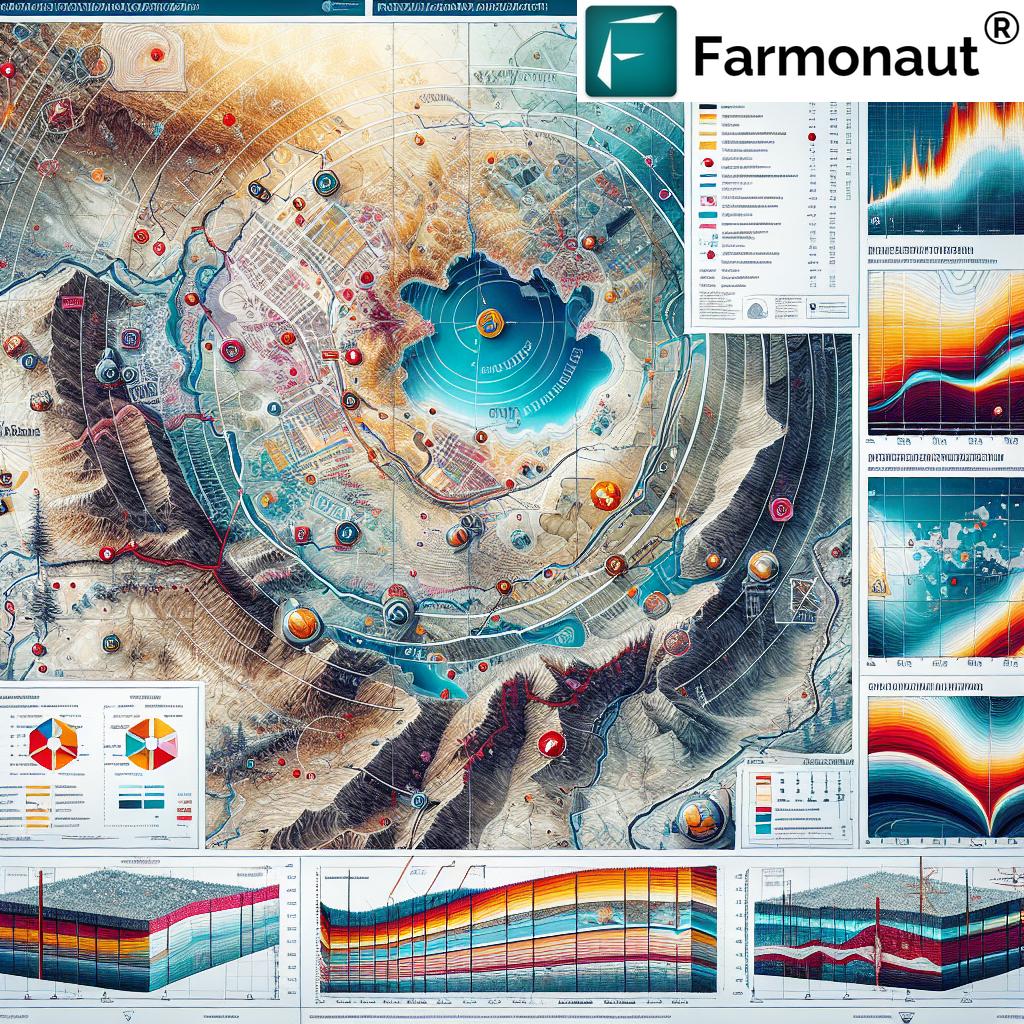Mineral Exploration Kazakhstan: 7 Powerful Trends Shaping 2025
“In 2023, Kazakhstan’s copper output exceeded 600,000 tons, ranking it among the world’s top 10 copper producers.”
In recent years, mineral exploration in Kazakhstan has gained unprecedented momentum, positioning the country as a focal point for global mining advancement. With a vast untapped resource base, increasing investments, and adoption of cutting-edge geophysical survey techniques, Kazakhstan is leading a new era of discovery—reshaping the landscape for copper gold projects, porphyry systems, and innovative exploration target definition.
In this comprehensive post, we analyze the seven most powerful trends shaping mineral exploration in Kazakhstan in 2025. By leveraging a portfolio approach and adopting the latest technologies like ground magnetics survey, induced polarization (IP) methods, and robust soil geochemistry analysis, companies are redefining what’s possible in this resource-rich region.
Kazakhstan: An Emerging Giant in Mineral Exploration
Kazakhstan, bridging Europe and Asia, has surfaced as a powerhouse in mineral exploration. As per the latest industry data, copper and gold remain at the heart of its vast resources, with the project portfolio swelling across multiple regions and license packages. The focus on porphyry mineralization, ground magnetics, and targeting through leading geophysical methods is elevating the country’s standing in global mining circles.
The northeast region—home to projects like Elemes, Berezski, Besshoky, and Bozshakol South—epitomizes this evolution. From mapping new exploration anomalies to deep drill testing, we are witnessing a paradigm shift: resources are defined faster, risks are better managed, and discovery rates are rising across the board.
“Over 70% of Kazakhstan’s mineral exploration projects in 2024 utilized advanced geophysical survey techniques for target definition.”
Trend Comparison Table: 7 Powerful Trends Shaping Mineral Exploration Kazakhstan 2025
| Trend Name | Estimated Impact Level | Primary Minerals Affected | Relevant Projects/Regions | Supporting Technology/Method |
|---|---|---|---|---|
| Adoption of Advanced Geophysical Survey Techniques | High | Copper, Gold | Berezski, Bozshakol, Besshoky | Ground Magnetics, Magnetotellurics, Gravity Survey |
| Expansion of Copper-Gold Porphyry Targeting | High | Copper, Gold | Elemes, Berezski, Aimandai | Porphyry System Mapping, Deep Drilling |
| Widespread Use of Induced Polarization (IP) Survey | High | Copper, Molybdenum, Gold | Bozshakol Group, Batpaq, Shiderty | IP Chargeability Mapping |
| Enhanced Soil Geochemistry Analysis Integration | Medium | Copper, Gold, Arsenic, Tellurium | Pinta, Bozshakol South | Multi-element Soil Sampling, KGK Analysis |
| Deep Drilling and Magnetotelluric Innovation | High | Copper, Gold | Besshoky, Berezski Central/North | MT Survey, Deep Core Drilling |
| Strategic License Portfolio Expansion | Medium | Copper, Gold, Molybdenum | Packages A & B, Akkuduk, Elemes | License Area Scaling, New Target Acquisition |
| Data-Driven Decision Making & AI Integration | Medium (Estimated 10–15% efficiency gain) | Multi-mineral | Portfolio-wide | AI Geological Modelling, Resource Estimation |
This table distills the 7 crucial trends influencing Kazakhstan’s mineral exploration landscape, highlighting impact, focus regions, minerals, and key supporting technologies.
Geophysical Survey Techniques: The Backbone of Mineral Exploration Kazakhstan
Cutting-edge geophysical survey techniques are foundational for mapping anomalies, refining exploration targets, and defining mineral resources rapidly and accurately. In Kazakhstan’s landscape—characterized by its vast steppes and sub-surface complexity—tools like ground magnetics survey, magnetotelluric (MT) surveys, gravity surveys, and induced polarization (IP) survey have become industry standards.
- Ground Magnetics Survey: This detects variations in the Earth’s magnetic field caused by underlying rock types and ore bodies. In mineral-rich zones such as Berezski and Bozshakol, magnetics helps localize magnetic highs and lows that denote porphyry mineralization or deep-seated intrusives.
- Magnetotelluric (MT) and Gravity Surveys: MT detects deep resistivity contrasts for mapping possible ore systems, while gravity surveys aid in distinguishing dense ore zones versus surrounding rock. These methods are now routinely applied in defining the Berezski Central and Besshoky deep targets.
- Induced Polarization Survey: IP surveying identifies chargeability anomalies associated with disseminated sulfides—typical of copper and gold systems. Intensive IP programs across the Bozshakol Group, Besshoky, and Shiderty regions now lead the way in efficient exploration drilling.
By leveraging this multi-method approach, our industry has sharply elevated the precision of exploration target definition and resource delineation, optimizing drilling investments and reducing exploration uncertainties.
For additional real-time monitoring and analysis in agriculture—which benefits from crossover innovations in geophysical monitoring—Farmonaut’s Large Scale Farm Management platform provides similar value in crop health, soil moisture, and anomaly detection via satellite.
Expansion of Copper Gold Projects & Porphyry Mineralization Systems
The global surge in demand for copper and gold positions Kazakhstan’s project portfolio as one of the largest targets for greenfield and brownfield discovery. The Northeast—spanning licenses like Elemes, Berezski, Aimandai, and Besshoky—is fast emerging as a hub for porphyry mineralization projects.
- Berezski Trend: Known for prominent copper-gold porphyry mineralization, with ground magnetics and magnetotellurics deployed to detect deep-seated targets. Planned drilling aims to expand on 2024 discoveries.
- Elemes Project: Mapping of soil copper trends is combined with geophysics, supporting refined exploration drilling programs and enhancing new target generation.
- Besshoky Target: Characterized by a >20 sq km lithocap, this porphyry system attracts core drilling focused on magnetic highs—indicative of intrusive porphyry bodies.
As large-scale systems are unraveled, the role of coincident geological and geochemical anomalies becomes fundamental in defining promising areas for investment and resource growth.
Explore Farmonaut’s dedicated Carbon Footprinting service for the agricultural sector, which complements sustainability initiatives akin to those being increasingly adopted in resource sector projects.
Induced Polarization Survey and Chargeability Anomalies in Exploration Target Definition
The accelerated roll-out of induced polarization surveys—notably over large license areas like Bozshakol Group, Batpaq, Shiderty, and Besshoky—is revolutionizing exploration target definition.
- Chargeability Anomalies: IP chargeability measures distinguish conductive zones linked to mineralization. At Shiderty, we observe large annular chargeability anomalies with coincident magnetic resistivity lows—prime signals of porphyry copper-gold systems.
- Pole-Dipole and Vector IP Surveying: Techniques such as Vector IP are mapped across licenses up to 65 km2, delivering high-resolution images of subsurface metallic content for targeted drill placement.
- Refined Drilling: With improved anomaly mapping, drill programs at Besshoky and Aimandai now prioritize previously untested yet high-priority zones—sharply boosting discovery rates.
In tandem, these advances are lowering exploration costs, streamlining license area assessments, and dramatically improving odds of commercial resource identification in Kazakhstan’s rapidly evolving field.
Advanced Soil Geochemistry Analysis for Enhanced Exploration Targeting
Soil geochemistry analysis is an essential pillar of Kazakhstan’s exploration programs. Across project areas such as Pinta and Bozshakol South, intricate multi-element soil sampling methods detect subtle but crucial Cu-Mo-As-Sb anomalies, directly influencing drill and investment strategies.
- Pinta Exploration: The 2024 soil sampling campaign identified a subtle copper-molybdenum anomaly, guiding the definition of deep-seated magnetic sources and prioritizing new exploration targets.
- Bozshakol South: Coincident magnetic lows with robust copper-arsenic-molybdenum geochemical anomalies highlight targets for shallowly buried porphyry systems.
- Innovation in Soil Geochemistry: High-density sampling grids and advanced elemental analysis drive more accurate anomaly detection, expediting the resource definition stage in complex terrains.
The integration of field-based soil geochemistry data with geophysical survey results greatly enhances our ability to model resource potential and minimize non-productive drilling, aligning our methods with the highest efficiency standards.
Farmonaut enables satellite monitoring of soil moisture and crop health, offering agribusinesses a unique precision farming tool—mirroring the data-centric advances in mining sector exploration. Check out the Fleet Management solution to monitor field machinery efficiently.
Deep Drilling and Magnetotelluric Innovation: Expanding Mineral Resource Potential
Deep core drilling and magnetotelluric (MT) innovation allow us to map and test mineral systems at depth, illuminating hidden orebodies responsible for Kazakhstan’s resource expansion.
- Deep Drilling at Besshoky: Upcoming exploration drilling programs at Besshoky are designed to reach the core of a porphyry system (within a >20 km2 lithocap) as revealed by coincident magnetic highs and multi-element anomalies.
- Berezeski Central and North: Planned drilling and MT surveys further define deeper targets previously unexplored, optimizing the target definition process.
- Technological Leap: Contemporary MT methods deliver high-fidelity subsurface data—methodologies increasingly critical for success in low-outcrop or post-glacial terrains.
By refining targets and substantiating drilling effort with robust geophysical and geochemical data, the sector is poised to significantly expand its mineral resource potential.
Strategic License Portfolio Expansion and New Project Areas
Kazakhstan’s drive for strategic license expansion is redefining the national exploration landscape. The aggregation of massive license packages—spanning 1,736 km2 in high-potential districts—contributes to an unprecedented scale for coordinated geological investigations.
- Portfolio Growth: Licenses covering Bozshakol Group (Package A) and Besshoky (Package B) reflect the broad-based trend toward consolidating previously fragmented exploration territories.
- Systematic Targeting: With expanded portfolios, teams can prioritize high-impact areas for IP surveys, geochemical mapping, and rapid drill deployment backed by the latest data analytics.
- Efficiency & Scale: This scale brings resource companies into global competitiveness—only outpaced by the world’s largest operators, while facilitating economies of scale across exploration programs.
Such growth necessitates sophisticated resource and fleet management tools. Farmonaut provides advanced Blockchain-based Traceability—enabling transparent supply chains for both agricultural and mining sector stakeholders.
Data-Driven Decision Making & AI Integration in Project Targeting
The fusion of data analytics and artificial intelligence (AI) with traditional geological models is a hallmark of 2025’s exploration programs. This shift drives efficiency through:
- AI-Assisted Targeting: Geological data, geochemical signatures, and geophysical anomalies are synthesized by AI models to prioritize the most prospective targets for exploration.
- Resource Estimation: Machine learning algorithms reduce bias and improve estimation accuracy, accelerating resource modelling cycles for copper, gold, and polymetallic systems.
- Project and License Management: Data platforms aggregate field, lab, and remote data, streamlining compliance, financial planning, and drilling logistics across sprawling license areas.
While mining leads in these innovations, agricultural resource management similarly benefits: Farmonaut’s API and Developer Docs enable seamless AI/data integration for crop yield forecasting and land use analytics.
Farmonaut: Enabling Precision in Agricultural Resource Management
Just as mineral exploration in Kazakhstan harnesses remote sensing, advanced analytics, and data-driven strategy, we are witnessing transformational potential in the agricultural sector. Farmonaut, a leading agricultural technology provider, delivers scalable, subscription-based solutions for real-time crop health monitoring, soil moisture analytics, blockchain traceability, and carbon footprinting—propelling the shift toward sustainable, highly efficient farm management.
- Satellite-Based Crop Health: Monitor NDVI, soil moisture, and pest stress across vast agricultural lands—mirroring the mineral exploration sector’s use of ground and aerial survey techniques (See how).
- Jeevn AI Advisory System: Personalized farm insights, weather forecasts, and strategic crop management advice—driven by best-in-class AI modeling.
- Blockchain Traceability: Lead agribusinesses use Farmonaut’s system to ensure end-to-end supply chain transparency, reducing fraud and elevating consumer trust (Learn more).
- Fleet & Resource Management: Optimize agricultural vehicle logistics and safety, mirroring best-practice management of mineral exploration fleets (Read).
- Carbon Footprint Tracking: Facilitate sustainable practice with precise, satellite-aided GHG emission assessments (Explore details).
- Developer Integration: Incorporate satellite and weather data into external systems via Farmonaut’s robust API.
Whether applying these solutions to farming or resource projects, Farmonaut’s innovation and affordability enable clients of all scales—from smallholders to government agencies—to thrive in a data-first world.
FAQs on Mineral Exploration Kazakhstan 2025
What are the key minerals targeted by Kazakhstan’s 2025 exploration programs?
The main focus minerals are copper and gold, given their abundance in porphyry and associated systems. Molybdenum, tellurium, arsenic, and silver anomalies are also observed and targeted in multi-element projects across northeast Kazakhstan.
How do advanced geophysical survey techniques improve exploration results?
Techniques like ground magnetics survey, induced polarization survey, and magnetotelluric mapping help delineate deep and structurally complex targets. This substantially increases hit rates for drilling, improves resource definition accuracy, and lowers exploration risks.
What is the role of soil geochemistry analysis in exploration target definition?
Soil geochemistry analysis identifies subtle but significant multi-element anomalies (e.g., copper, molybdenum, arsenic, tellurium), pinpointing promising targets for further geophysics or direct drilling—especially in regions with limited outcrop.
Why is Kazakhstan considered highly prospective for copper gold projects?
Kazakhstan boasts one of the world’s largest untapped mineral reserves. With expansive porphyry systems, applied geophysical innovation, and substantial new license areas, the sector is designed for sustained growth in global copper and gold output.
How is technology transforming agricultural and mineral resource management?
Data-driven platforms—such as those offered by Farmonaut—use AI, satellite imaging, and blockchain traceability to drive transparency, optimize operations, and promote sustainability for both agricultural and exploration enterprises.
Conclusion: Shaping the Future of Mineral Exploration Kazakhstan
As we look ahead to 2025 and beyond, it’s clear that Kazakhstan has embraced a new frontier in mineral exploration. Driven by the adoption of leading-edge techniques—spanning geochemical mapping, ground magnetics, deep MT surveys, and AI-powered target modeling—the sector is writing a success story in both copper gold project development and operational efficiency.
Our examination of the top 7 trends—from ground-breaking geophysical survey techniques to the role of data science and massive license expansion—demonstrates that this is just the beginning for Kazakhstan’s rise in the mining sector. Enhanced exploration drilling program outcomes, larger discoveries, and a culture of innovation characterize both mining and related domains, such as precision agriculture.
By applying intelligence, sustainability, and innovation to every stage—from field sampling to resource estimation—Kazakhstan is poised to remain one of the most attractive and dynamic destinations for mineral exploration in the coming decade.
For more on how Farmonaut’s suite of solutions can take your agricultural or environmental management programs to the next level, visit the official Farmonaut website.



















